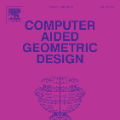【多媒体类】会议/期刊截稿信息5条
图形学与多媒体
SIGNAL 2018
International Conference on Advances in Signal, Image and Video Processing
全文截稿: 2018-01-03
开会时间: 2018-05-20
会议难度: ★
CCF分类: 无
会议地点: Nice, France
网址:http://iaria.org/conferences2018/SIGNAL18.html
SIGNAL 2018 is colocated with the following events as part of InfoSys 2018.
SIGNAL 2018 conference tracks:
-Architectures and frameworks
-Signal processing theory and methods
-High speed signal processing: integrating 5G and IoT with satellite networks
-Signal/image metrics
-Features and models for images/signals
-Image/signal computation and services
-Special signal, image and video processing applications/domains
-Hands-free speech communication and microphone arrays
-Wearable sensor signal processing
图形学与多媒体
Computer Aided Geometric Design
Special Issue on “Heat Diffusion Equation and Optimal Transport in Geometry Processing and Computer Graphics”
全文截稿: 2018-02-19
影响因子: 1.364
CCF分类: B类
中科院JCR分区:
• 大类 : 工程技术 - 4区
• 小类 : 计算机:软件工程 - 3区
• 小类 : 应用数学 - 3区
网址: http://www.journals.elsevier.com/computer-aided-geometric-design
In geometry processing and shape analysis, several problems and applications have been addressed through the properties of the solution to the heat diffusion equation and to the optimal transport. For instance, diffusion kernels allow us to define diffusion distances, shape descriptors and clustering methods, to approximate geodesics and optimal transport distances, to deform 3D shapes, to smooth and approximate signals in a multi-scale fashion. Optimal transport has been successfully applied to volume parameterization, surface registration, inter-surface mapping, shape matching and comparison. Furthermore, the heat diffusion equation and the optimal transport are intrinsically correlated and central in different research fields, such as Computer Graphics, Geometry, Manifold Learning, and Differential Equations.
This Special Section of the CAGD Journal, published by Elsevier, covers a range of topics on the properties, discretization, computation, and applications of the heat equation and the optimal transport in the context of Computer Graphics, Computer-Aided Geometric Design, and related research fields. The topics range from geometry processing to high-level understanding of 3D shapes, and more generally n-dimensional data, including feature extraction, segmentation, and matching. The list of suggested topics includes but is not limited to:
• Heat diffusion equation
• Diffusion kernels and distances
• Diffusion shape descriptors
• Multi-scale modeling and approximation
• Optimal transport
• Wasserstein distance
• Geometry processing applications
• Surface parameterization
• Shape modelling applications
• Shape matching and comparison
• Dynamic surface tracking
• Shape analysis and retrieval
• Shape correspondence and registration
• Manifold learning
• Generative model in Machine Learning
• Clustering and dimensionality reduction
• Applications to Geometry Processing
• Applications to Computer Graphics
• Applications to Computational Geometry
• Applications to 3D Printing
• Applications to Material Design
• Applications to Computer Vision
• Applications to Medicine (e.g., brain and neuro-imaging)
图形学与多媒体
ICVMIP 2018
International Conference on Visual Media Innovation and Production
全文截稿: 2018-02-25
开会时间: 2018-07-27
会议难度: ★
CCF分类: 无
会议地点: Bangkok, Thailand
网址:http://www.icvmip.org/
2018 2nd International Conference on Visual Media Innovation and Production (ICVMIP 2018) will be hosted in Bangkok, Thailand from July 27-29, 2018.
ICVMIP 2018 is an international forum for the presentation of technological advances and research results in the fields of Visual Media Innovation and Production. The conference will bring together leading researchers, engineers and scientists in the domain of interest from around the world. We warmly welcome prospected authors submit your new research papers to ICVMIP 2018, and share the valuable experiences with the scientist and scholars around the world.
All the papers will be peer reviewed by 2-3 experts. The review result comes out in 20-30 days. If the paper needs revising, the revised copy should be submitted again for peer review. All the accepted papers will be included in the conference proceeding(Online Publish), which will be indexed by Ei Compendex, CPCI, Scopus, CPCI and other academical databases.
图形学与多媒体
MCCAI 2018
International Conference on Medical Image Computing and Computer Assisted Intervention
摘要截稿: 2018-02-23
全文截稿: 2018-03-02
开会时间: 2018-09-16
会议难度: ★★★
CCF分类: 无
会议地点: Granada, Spain
网址: www.miccai2018.org/en/default.asp
Like previous years, you will have to register your intention-to-submit by Midnight, Pacific Time, February 23rd, 2018 from the online system which will be available in coming days at this page. You will not be able to submit your paper if you do not register with an intention-to-submit. Please see important dates on the website for further details on the submission and review schedule.
The full paper submission deadline will be Midnight, Pacific Time, March 2nd, 2018. There will be no extension.
In addition to advances in methodology, we encourage submission of papers that demonstrate clinical relevance and novel clinical applications. Topics discussed at MICCAI include, but are not limited to:
1. Medical Image Computing
-Machine Learning and Artificial Intelligence
-Image Segmentation, Registration and Fusion
-Image Reconstruction and Image Quality
-Computational Anatomy and Physiology
-Microscopy and Histology Image Analysis
-Computer Aided Diagnosis
-Population Imaging and Imaging Genetics
-Applications of Big Data in Imaging
-Integration of Imaging with Non-Imaging Biomarkers
-Visualisation in Biomedical Imaging
2. Computer-Assisted Interventions
-Surgical Data Science
-Interventional Imaging Systems
-Image-Guided Interventions and Surgery
-Interventional Tracking and Navigation
-Medical Robotics and Haptics
-Surgical Skill and Work Flow Analysis
-Surgical Planning and Simulation
-Surgical Visualization and Augmented Reality
-Interventional Software and User Interfaces
图形学与多媒体
Signal Processing: Image Communication
Special Issue on Advances in statistical methods-based visual quality assessment
全文截稿: 2018-05-31
影响因子: 2.244
CCF分类: C类
中科院JCR分区:
• 大类 : 工程技术 - 3区
• 小类 : 工程:电子与电气 - 3区
网址: http://www.journals.elsevier.com/signal-processing-image-communication/
Visual information, represented by various types of images and videos, is omnipresent, substantial, indispensable, diverse and complicated in our daily life. Regardless of being raw or processed, visual information is ultimately received and interpreted by our human beings. To assess the quality of images and videos, some traditional measures like the Peak Signal to Noise Ratio (PSNR) has been widely used. However, the inconsistency between these traditional measures and the human vision system (HVS) has hindered the development of visual information processing. Being aware of this problem, a large number of practitioners from the computer vision and image processing communities have focused on developing new metrics of visual quality assessment (VQA), which are designed perceptually more consistent to the HVS. In early research, they focused on imitating the HVS with the help of psychophysics. Then the trend in research became to treat the HVS as a black box and just imitate its functions. More recently, the practitioners start to exploit the links between statistics and the HVS, which were shaped and developed throughout the evolution of the HVS. In fact, the use of statistics, including the local and global summary statistics, statistical models and statistical machine learning techniques, becomes more and more popular in each constituent module of VQA, no matter there is reference information or not for assessment.
In this context, this special issue aims to call for the state-of-the-art research in the technology, methodology, theory and application of VQA, especially the statistics-related aspects involved in VQA. It also aims to demonstrate the recent efforts made by the relevant researchers in the fields of computer vision, image processing, statistics and machine learning.
We welcome all the relevant, original work, including but not limited to:
- Statistics for natural scenes.
- Statistics for specific types of image, such as screen content images.
- Statistics for specific distortions of image.
- Spatial and temporal statistics for videos.
- Statistics-based perceptual features for VQA.
- Statistical machine learning for VQA.
- Deep learning for VQA.
- Hybrid statistical and non-statistical learning for VQA.
- Statistics-based pooling strategies in VQA.
- Statistical evaluation of VQA methods.
- Statistical analysis and interpretation of existing VQA methods.
- VQA algorithms for image/video compression, denoising, restoration, enhancement, super-resolution, etc.
- VQA applications in biometrics, medical imaging, remote sensing, security, etc.
- VQA databases.
下载Call4Papers App,获取更多详细内容!


登录查看更多
相关内容
Processing 是一门开源编程语言和与之配套的集成开发环境(IDE)的名称。Processing 在电子艺术和视觉设计社区被用来教授编程基础,并运用于大量的新媒体和互动艺术作品中。
Arxiv
59+阅读 · 2020年1月20日
Arxiv
78+阅读 · 2019年11月10日
Arxiv
4+阅读 · 2018年1月30日




